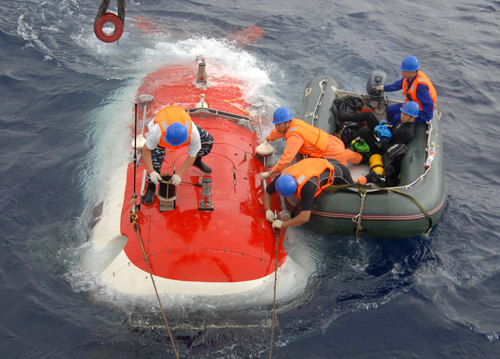|
 |
|
NEW DEPTHS: China's manned submersible Jiaolong emerges after diving more than 5,000 meters under sea level in the northeast Pacific on July 28, 2011 (XINHUA) |
The International Seabed Authority (ISA) signed a contract on the exploration of polymetallic sulphides submitted with the China Ocean Mineral Resources Research and Development Association (COMRA) in November 2011. Surprisingly, the event has been hyped as an addition to the "China threat" by critics with ulterior motives. They say China is extending its tentacles into the Indian Ocean, challenging the oceanic interests of India. These accusations are both ignorant and absurd.
Participation
The newly contracted exploration area is located in the mid-oceanic ridge in the southwest Indian Ocean. It lies in the international seabed area outside the national jurisdiction of coastal countries. The contract area covers about 10,000 square km.
According to the contract, in the next 15 years, the COMRA will be obligated to conduct environmental monitoring and surveying in the area and coach researchers from developing countries. And within 10 years after the signing of the contract, the COMRA should return 75 percent of the exploration area to the ISA and retain the remaining portion as an area where it is entitled to priority mining rights.
The contract made China the first country that has signed two exploration contracts with the ISA. The COMRA began participating in resource exploration activities in international seabed areas more than 20 years ago. In March 1991, the UN approved a 15,000- square-km international seabed area in the northeast Pacific for the COMRA to conduct resource exploration.
In accordance with the UN Convention on the Law of the Sea (UNCLOS) adopted in 1982, the COMRA relinquished half of this area in March 1999. In 2001, it signed a polymetallic nodule exploration contract with the ISA, gaining priority mining rights in the remaining half of the exploration area.
Regulations
There are specific regulations on resource exploration activities in international seabed areas in the UNCLOS. The UNCLOS defines international seabed areas as the seabed, ocean floor and subsoil beyond the limits of national jurisdiction. They encompass the seabed and subsoil that underlie the high seas, but are outside the continental shelf areas claimed by coastal states.
| 